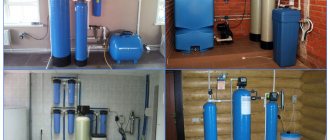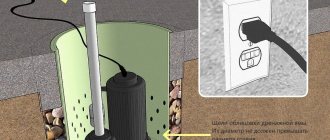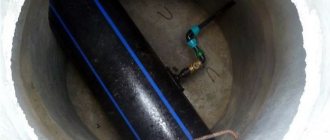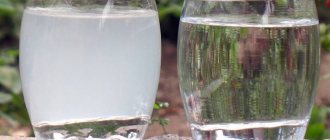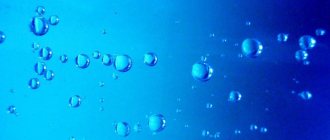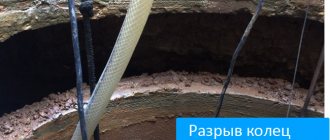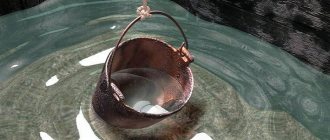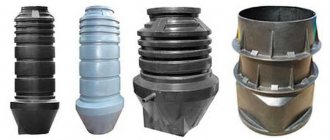Disinfection of the well should be carried out on a regular basis, because contamination of the contents by microorganisms and mold will lead to various pathologies. There are many ways to purify liquid using household chemicals, folk remedies, and modern devices.
Disinfection of a well using potassium permanganate.
Causes of pollution
The depth of groundwater is shallow, so the source is not always clean. There are dissolved or dry impurities in the well. Microorganisms live and develop in the upper layers, the decomposition of which causes an unpleasant taste or aroma of the liquid.
Causes of infection Source kolodetsoved.ru
Well water is susceptible to contamination more often than moisture from a centralized main. There are 3 types of reasons:
- Natural phenomena. The culprits are floods or changes in underground sources due to heat and exposure to sunlight. Transformations occur when accidentally exposed to the corpses of animals, birds or fallen leaves.
- Human factor. The close location of a drainage pit, a cattle pen, and the active use of fertilizers provoke contamination of the water in the well. Chemical or agricultural runoff may enter the source.
- Structural destruction. Due to improper installation and active use, the seams become depressurized and the well elements break.
Often wells are installed on quicksand. Due to the high content of impurities in the water, the owner will have to control the concentration and eliminate the signs. The soil around the structure is subsiding and the seams may become depressurized, leading to moisture contamination.
Well contamination Source sovet-ingenera.com
Causes of dirt in water Source sovet-ingenera.com
Pros and cons of potassium permanganate as a water purification agent
The main advantages of potassium permanganate for water disinfection are ease of processing and availability. But there are other advantages:
- disinfection efficiency is about 99% (potassium permanganate is a strong oxidizing agent that neutralizes the bulk of pathogenic microorganisms and their metabolic products);
- at the correct concentration does not harm human health;
- versatility of use - used for drinking, technical and other water.
Despite many advantages, manganese also has disadvantages:
- the duration of the disinfecting effect is short-term;
- after disinfection, filters must be installed;
- Caution is needed when working with the substance, since a strong concentrate of the solution or the crystals themselves can lead to burns and poisoning.
The main difficulty is that potassium permanganate is not currently sold without a prescription, so it is not possible to buy it in the required quantity.
Main features
The composition of water in a well depends on seasonal changes and external influences. To control the quality of an underground source, you need to regularly do research. There are 4 signs that will warn you about the need to disinfect a well.
Color change
Pure water is always clear, without any shades. If the liquid turns green, then the moisture “blooms”. When direct sunlight enters the mine, algae and bacteria begin to multiply and develop. Colonies of microorganisms in the form of tiny balls can be seen with the naked eye.
Black water in a well is the result of rotting organic matter. Due to the decomposition of leaves, animal carcasses, insects or birds, substances are released that contaminate the moisture. Decomposition products are poisonous to living beings, so the liquid must be disinfected.
Yellow or brown color of water in the well warns of high iron content. The element reacts with air, causing rust to occur. The substance can be either in the liquid itself or in the metal parts of the structure (pipes, filter).
Color change Source serovglobus.ru
Yellow water occurs in wells that were dug in violation of technology. Shallow homemade wells are located in layers with a high concentration of sand or clay. Poor sealing of the seams between the rings of the structure leads to the penetration of impurities and staining of moisture.
Turbidity and sediment
Violation of transparency warns of the need to disinfect the water in the well. Sticky silt forms on the walls of the well or fine dust collects, which makes the liquid cloudy. The problem appears after rain when the tightness of the structure deteriorates.
If the pump is installed incorrectly, the transparency of the water in the well is impaired. The distance from the bottom to the suction part of the device should be within 70-80 cm. If the device is installed incorrectly, then upon startup it will raise sediment. The liquid becomes cloudy and sediment forms, which must be removed.
Reasons for opacity Source stroymore.ru
An oil film above the surface of the water in a well warns of oil products entering the well. A rainbow spot occurs when the seams on the walls are depressurized or when the pump fails. Often the cause is a gasoline lighter that fell out of the owner's pocket and ended up in a mine shaft.
Foreign odor
Biological or chemical processes in a well manifest themselves as aromas in the water. When organic matter decomposes, hydrogen sulfide is released, and the liquid acquires the aroma of rotten eggs. The moisture is not dangerous to humans, but due to the smell it is impossible to drink and use for household needs.
If garbage constantly gets into the well, the water smells like rottenness or swamp. Mechanical impurities settle to the bottom, where decomposition occurs. In the early stages, the liquid does not become cloudy or change color. An unpleasant aroma and the presence of splinters (sticks) warn of contamination of the source.
Unpleasant amber of water Source watertestingkits.com
If the moisture in the well smells like detergent, gasoline or phenol, this indicates the presence of wastewater in the aquifers. Unnatural odors appear when chemical products come into contact with them. Hazardous components from sediments entered underground sources.
Taste of water
A metallic taste in well moisture indicates the presence of iron in the composition. Sourness is a sign that water is in contact with bronze or copper parts in the well. Increased salt content manifests itself in the form of brackish water. Bitterness warns of contamination from domestic wastewater.
Unusual taste of water Source yandex.ua
Precautions when working with potassium permanganate
When interacting with potassium permanganate, you should adhere to generally accepted safety rules:
- when treating wells, act quickly, do not stay at the bottom for a long time, as the substance evaporates and the vapors harm the body;
- use respirators with a double protective filter;
- wear rubber gloves and long sleeves;
- Allergy sufferers are not recommended to come into contact with the drug;
- When diluting crystals in water, select transparent containers to see particles that have not yet dissolved.
If the product gets on mucous membranes or skin, immediately rinse the area with plenty of running water.
The correct use of potassium permanganate when disinfecting water is the key to high-quality disinfection. Follow safety precautions, keep the substance away from children, and strictly monitor the concentration of the product to avoid unpleasant consequences.
How to determine quality
Signs of infection indicate the need to clean the water in the well. To begin eliminating the problem, you need to identify the culprit. Laboratory analysis will help identify the cause of contamination. Research is carried out by sanitary and epidemiological stations, accredited centers of Rospotrebnadzor or private companies with a license.
Liquid studies Source stroy-podskazka.ru
Water from the well is poured into a clean glass or new plastic bottle with a volume of 1.5 liters. The liquid is carefully added to the container, otherwise excess oxygen will form inside due to the strong pressure. The reservoir is tightly sealed, wrapped in dark polyethylene and delivered to the laboratory within 3 hours.
The result is a conclusion about the organoleptic characteristics and qualities of the well. Experts summarize whether the well is suitable for use for household and food purposes, and prescribe recommendations for improving the water.
Prevention
In order to carry out disinfection measures as rarely as possible, but at the same time use high-quality water, it is necessary to follow a number of measures aimed at preventing contamination of the well.
Such measures include the following:
- the well must not be left open;
- maintain a distance of at least 20 meters from the well to the sewerage and drainage system;
- reliably seal the walls of the well, preventing the penetration of groundwater;
- use submersible pumps with remote injectors, this significantly reduces the number of leaks;
- Observe sanitary standards and do not pour waste into the well.
Following these simple measures will avoid clogging and silting of the well, which are the most likely causes of deterioration in water quality.
Timely preventive disinfection will allow you to keep the well in the required sanitary condition and will make it possible to safely use water from it for various household needs.
Preparation for processing
The quality and speed of cleaning depends on the preparatory procedures. Before the event, liquid is pumped out of the well. A household surface apparatus can handle a small volume of water. When there is a significant level of moisture, a submersible model is lowered into the shaft. To prevent debris from getting into the device, floating debris is collected with a net or a net with a long handle.
Scoop out dirty water Source build-experts.ru
Before disinfecting water in a well, you need to check the reliability of the structure. A man on a cable descends into the well and carefully examines the walls. Silt, sediment, and algae are removed from surfaces using hard brushes and spatulas of various sizes. Leaks and cracks are sealed with a solution with waterproofing properties. Mold is disinfected with copper sulfate.
The remaining water from the bottom is scooped out with a bucket. The bottom of the well is thoroughly cleaned of sediment, the old bottom filling is removed and replaced with a new composition. Due to its low weight and toxicity, expanded clay is contraindicated as a filter. For the well use:
- river gravel;
- small crushed stone;
- sand.
The shift of the lower rings occurs due to the influence of quicksand. The rupture areas are treated with cement mortar. Displacement of the upper structures occurs after the ground freezes. The parts are held together with fasteners made of thick, strong wire.
Restoring seam sealing Source kolodcy-pod-klyuch.ru
Plaque on the concrete rings of the well must be removed. Mechanical tools and chemicals are used to eliminate it. Salt deposits can be removed with acid-based substances. Corroded spots are removed with a jackhammer or leveled with a grinder. The cleaned metal is treated with a waterproof anti-corrosion solution.
Physical methods of disinfection
These methods include cleaning using ultrasound and ultraviolet light. These methods are efficient and environmentally safe. The main disadvantage is the need to purchase expensive devices. It is rational to use such equipment if the well is connected to an autonomous water supply system and is used year-round.
The cleaning device is equipped with an automatic system that regulates the water supply through a special unit. This emits ultraviolet light, which is harmful to bacteria. At the same time, the smell and color do not change. However, such a device is not used if there is no cover at the well. The equipment that influences mold with ultrasonic waves operates in almost the same way.
Disinfectants
Disinfection of water in a well is carried out with special preparations with disinfectant and antibacterial properties. Well products must destroy pathogenic microflora, quickly erode or disintegrate into components that are safe for people. There are 9 methods that can be used at home.
White
An inexpensive, simple option is used to disinfect a well. A chlorine-based chemical is suitable for a moderately neglected well. Take 1 liter of the drug per ring of the structure. The product is poured over the walls from the bucket, the surface is thoroughly smeared with a brush on a long pole. If you have a garden sprayer, it is easier to spray the disinfectant liquid.
The well is covered with thick cloth or polyethylene, left for a day in cold weather, and for 10 hours in warm weather. Ultraviolet radiation should not enter the well, otherwise the bleach will disintegrate under the influence of the sun. The absence of the smell of "Whiteness" in the mine indicates the destruction of the chemical. To disinfect the structure, the procedure must be repeated.
Bleach for disinfection Source remontkit.ru
After disinfection of the well is completed, the walls are washed with chlorinated liquid, then with clean liquid. The water is pumped out until the smell of the drug disappears. The moisture in the well cannot be used for drinking for 7-10 days.
Lime
One percent chlorine comes in the form of a white powder. The product in plastic bags of various packaging can be purchased at hardware or construction stores. To prepare the essence, 10 g of the substance is dissolved in 1 liter of pure liquid. To disinfect water in a well, take 400 ml of the prepared solution per 1 m3 of moisture in the well.
Chlorine for wells Source plesneveet.ru
If the structure is small, then the chemical liquid is poured into the source along the walls. A large shaft is treated with a special stick with a brush or sponge at the end. Manipulations are carried out for 10 minutes, after which the well is covered from the sun with a film (thick cloth). In summer, 6 hours of disinfection is enough; in autumn or early spring, the lime is left for 12-24.
Upon completion of the procedure, the chemical solution is thoroughly washed off the walls of the well. The moisture is pumped out until the chlorine odor disappears. As with Belizna, the liquid will become suitable for drinking after 10 days.
Preventive measures
Complete disinfection and repair of structures is carried out once every 5-7 years. To minimize costs and prevent water contamination, regular light cleaning and disinfection are needed. If the well is used constantly, then one procedure per year is sufficient. At summer cottages, activities are carried out at the beginning and end of the season.
After cleaning the well Source yandex.ua
To prevent rain and wastewater from entering the well, a clay castle is installed around the structure. The device acts as a water seal, suitable for areas with a risk of floods or swamps. The element protects concrete rings from clogging with soil and upper groundwater.
To create a castle, a trench is dug around the well, the depth of which is between 1.7-2 m and a width of up to 1 m. The ditch is filled with dense (“greasy”) clay with a high degree of viscosity. The wet substance is compacted around the concrete rings. To allow water to drain, the upper part of the structure is installed above the ground.
A properly selected bottom filter independently copes with the disinfection of moisture in the well. The device purifies liquid by chemical and physical methods. Zeolite is added along with traditional quartz sand and river pebbles. Jadeite (bath stone) removes heavy metals and prevents the movement of materials in the lower layer.
If the well is located on quicksand or water flows under high pressure, then a bottom shield is needed. The iron alloy mesh breaks down due to corrosion and substances penetrate into the drinking moisture, which can affect the taste or color. Aspen structures do not rot, do not change the aroma and additionally disinfect the liquid.
Well cleaning Source yandex.ua
The cap not only has a decorative function, but also prevents contamination of the well. The water in a closed well does not bloom, leaves, dust or dead animals (insects) do not get inside. The structure in the form of a cover or canopy can be assembled from wood, stone or siding, adapting it to the landscape design.
